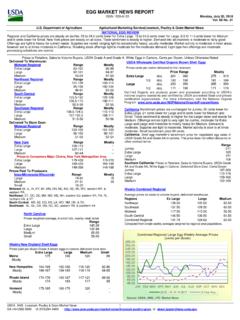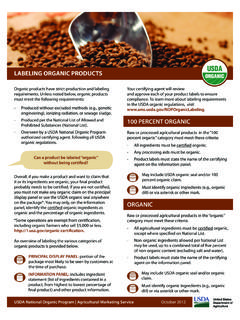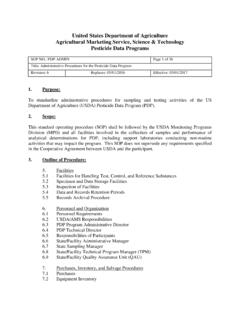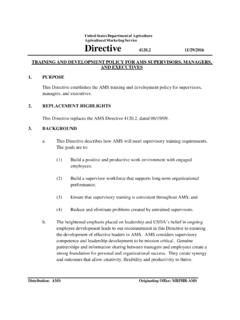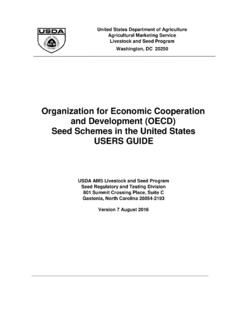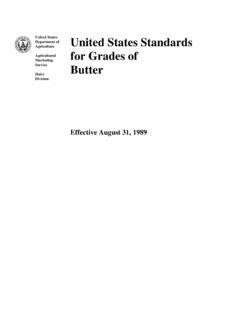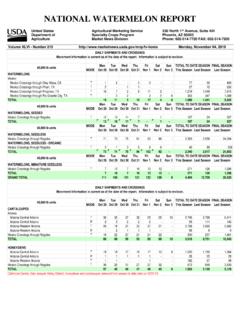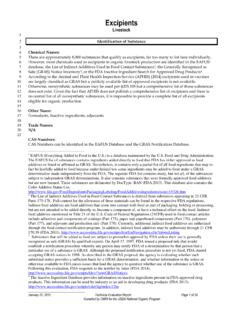Transcription of US A efinition of Specialty rop
1 USDA Definition of Specialty Crop BAC K GROUND The purpose of this document is to facilitate coordination among the various US Department of Agriculture (USDA) agencies with programs that address the needs of Specialty crop producers, handlers and processors. Although a common definition of Specialty crops across these agencies is desirable for USDA stakeholders and customers, it is also recognized that the mission of each agency is unique and so the application of a common definition might vary. It is also recognized that individual states may wish to modify the definition used by USDA to satisfy local or regional needs. The agencies involved in this effort were the Agricultural Marketing Service (AMS), the National Institute of Food and Agriculture (NIFA), the Foreign Agricultural Service (FAS), the National Agricultural Statistics Service (NASS), the Office of the Chief Economist (OCE), Forest Service (FS), the National Resource Conservation Service (NRCS) and the Risk Management Agency (RMA).
2 WHAT ARE SP EC IAL T Y CROPS? Specialty crops are defined in law as fruits and vegetables, tree nuts, dried fruits and horticulture and nursery crops, including floriculture. This definition, although more exact than previous legal definitions, leaves a certain amount of latitude in interpretation. Fruits, vegetables, tree nuts, nursery crops and floricultural crops are all considered to be horticultural crops. Regardless, the specific mention of these crop groups means that plants so classified automatically qualify as Specialty crops. Where interpretation is needed is in which plants, not specifically mentioned in legislation, can be classified as horticulture (sic) crops. WHAT I S HORT IC UL T URE? Horticulture is defined as that branch of agriculture concerned with growing plants that are used by people for food, for medicinal purposes, and for aesthetic gratification.
3 Horticulture is divided into specializations. The terms used to describe these specializations derive from millennia of common usage and are sometimes at odds with botanical nomenclature. For example, vegetables are described as herbaceous plants of which some portion is eaten raw or cooked during the main part of a meal. Fruits, for horticultural purposes, are described as plants from which a more or less succulent fruit or closely related botanical structure is commonly eaten as a dessert or snack. By these definitions, plants such as tomato, squash and cucumber are considered vegetables despite the fact that the edible portion is defined botanically as a fruit. The delineation of plants by common usage was legally established in 1893 by the unanimous Supreme Court decision in the case of Nix vs.
4 Hedden 149 304. Over the last 60 years, agriculture, including horticulture, has become increasingly reliant on science and technology to maintain profitable production. The scientific study of horticulture is divided into various sub-disciplines. Pomology is defined as that branch of horticulture dealing with fruit and tree nut production. Fruit production includes the so-called tree fruits; such as apple, peach, and orange, and small fruits; such as strawberry, blueberry, and raspberry. Olericulture is defined as that branch of horticulture dealing with the production of vegetables and herbs. Floriculture is that branch of horticulture dealing with the production of field-grown or greenhouse-grown plants for their flowers or showy leaves. Environmental horticulture is that branch of horticulture that deals with the production of plants for ornamental use in constructed environments, both indoors and outdoors.
5 There are many facets to environmental horticulture. Nursery production involves growing plants under intensive management for use in another location. Nurseries are defined in a variety of ways: a) the type of plant grown, such as fruit tree , turf or Christmas tree nurseries; b) the function of the nursery, such as production, wholesale, retail, mail-order or landscape nurseries; and c) the production system, such as field-grown or container-grown. Landscape horticulture involves the design, installation, and maintenance of both outdoor and indoor environments. Public horticulture involves the design and maintenance of arboreta, public gardens, parks, and athletic facilities. Horticultural therapy involves the use of horticultural plants to improve the condition of people with physical, intellectual or emotional disabilities.
6 Horticultural therapy also includes the use of plants in hospitals and other medical facilities to ease the pain and suffering of patients. Home horticulture involves the use of horticultural plants as a recreational activity, generally by non-professionals. Home horticulture is the most popular hobby in the United States with a commercial value of over $35 billion in 2012. WHAT ARE C ROPS? There are many definitions of the word crop . When referring to plants, USDA considers crops to be those plants that are cultivated either for sale or for subsistence. There are many plants that are Specialty crops when cultivated, but are also collected from wild populations. Wild plants are not considered Specialty crops even though they may be used for the same purpose as cultivated plants.
7 This is somewhat common among medicinal herbs and woodland plants. There are a number of native ferns that are collected from wild populations for use in the floral trade. There are also a number of marine plants that are collected from wild populations both for direct consumption and for industrial uses. Although these are Specialty uses, wild plants are not considered Specialty crops by USDA. However, natural populations of native plants that are brought into cultivation, such as sugar maple trees, pecans, blueberry, huckleberry and cranberry are considered Specialty crops by USDA. In order for a plant to be considered cultivated, some form of management must be applied. The intensity of the management is not critical to determining whether a plant is cultivated or not.
8 This definition includes plants or plant products harvested from wild areas whose populations are managed, monitored and documented to ensure long-term, sustainable production. If a naturally occurring population of plants is brought under management and that plant satisfies the definition of Specialty crop presented in the second paragraph of this document, then those plants would be considered Specialty crops. It is common for such plants to be designated wild-harvested for marketing purposes. Such a designation does not preclude a plant from being considered a Specialty crop as long as the above criteria are met. For the purpose of some programs in which state agencies are the eligible entities, states may choose to define plants collected from the wild as Specialty crops.
9 Similarly, some cultivated plants have multiple uses. Amaranth may be grown as a leafy green, or it may be grown as a grain. Leafy greens are vegetables, therefore amaranth grown in such a manner would be considered a Specialty crop. However, grains are not Specialty crops, therefore amaranth grown for grain would not be considered a Specialty crop. There are many other examples of crops with multiple uses and an exhaustive list would not be possible here. However, the following groups of crops are not considered Specialty crops: grains (corn, wheat, rice, etc.), oil seed crops (canola, soy bean, camelina, etc), bio-energy crops (switchgrass, sugar cane, etc), forages (hay, alfalfa, clover, etc.), field crops (peanut, sugar beet, cotton, etc.)
10 , and plants federally controlled as illegal drug plants (cannabis, coca). The following appendices give examples of plants that are considered Specialty crops by USDA. These appendices are not intended to be all-inclusive, but rather are intended to give examples of the most common members of the various groups. APPE ND IX A PL ANT S C OM M ONL Y C ONSID ERED F RUIT S A ND T R EE N UT S Almond Grape (including Raisin) Apple Guava Apricot Kiwi Aronia berry Litchi Avocado Macadamia Banana Mango Blackberry Nectarine Blueberry Olive Breadfruit Papaya Cacao Passion Fruit Cashew Peach Citrus Pear Cherimoya Pecan Cherry Persimmon Chestnut (for Nuts) Pineapple Coconut Pistachio Coffee Plum (including Prune) Cranberry Pomegranate Currant Quince Date Raspberry Feijou Strawberry Fig Suriname Cherry Filbert (Hazelnut) Walnut Gooseberry APPE ND IX B PL ANT S C OM M ONL Y C ONSID ERED VE GET ABL ES Artichoke Mushroom (Cultivated)
